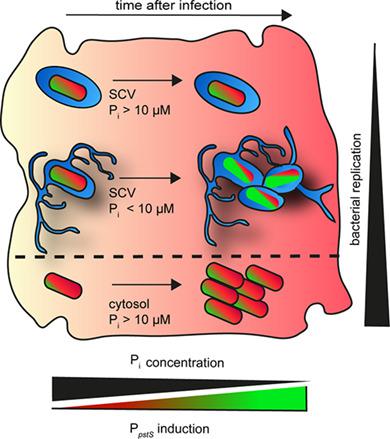当前位置:
X-MOL 学术
›
Cell. Microbiol.
›
论文详情
Our official English website, www.x-mol.net, welcomes your feedback! (Note: you will need to create a separate account there.)
Single-cell analyses reveal phosphate availability as critical factor for nutrition of Salmonella enterica within mammalian host cells
Cellular Microbiology ( IF 3.4 ) Pub Date : 2021-06-23 , DOI: 10.1111/cmi.13374 Jennifer Röder 1 , Pascal Felgner 1 , Michael Hensel 1, 2
Cellular Microbiology ( IF 3.4 ) Pub Date : 2021-06-23 , DOI: 10.1111/cmi.13374 Jennifer Röder 1 , Pascal Felgner 1 , Michael Hensel 1, 2
Affiliation

|
Salmonella enterica serovar Typhimurium (STM) is an invasive, facultative intracellular pathogen and acquisition of nutrients from host cells is essential for survival and proliferation of intracellular STM. The nutritional environment of intracellular STM is only partially understood. We deploy bacteria harbouring reporter plasmids to interrogate the environmental cues acting on intracellular STM, and flow cytometry allows analyses on level of single STM. Phosphorus is a macro-element for cellular life, and in STM inorganic phosphate (Pi), homeostasis is mediated by the two-component regulatory system PhoBR, resulting in expression of the high affinity phosphate transporter pstSCAB-phoU. Using fluorescent protein reporters, we investigated Pi availability for intracellular STM at single-cell level over time. We observed that Pi concentration in the Salmonella-containing vacuole (SCV) is limiting and activates the promoter of pstSCAB-phoU encoding a high affinity phosphate uptake system. Correlation between reporter activation by STM in defined media and in host cells indicates Pi concentration less 10 μM within the SCV. STM proliferating within the SCV experience increasing Pi limitations. Activity of the Salmonella pathogenicity island 2 (SPI2)-encoded type III secretion system (T3SS) is crucial for efficient intracellular proliferation, and SPI2-T3SS-mediated endosomal remodelling also reliefs Pi limitation. STM that are released from SCV to enter the cytosol of epithelial cells did not indicate Pi limitations. Addition of Pi to culture media of infected cells partially relieved Pi limitations in the SCV, as did inhibition of intracellular proliferation. We conclude that availability of Pi is critical for intracellular lifestyle of STM, and Pi acquisition is maintained by multiple mechanisms. Our work demonstrates the use of bacterial pathogens as sensitive single-cell reporters for their environment in host cell or host organisms.
中文翻译:

单细胞分析揭示磷酸盐的可用性是哺乳动物宿主细胞内肠沙门氏菌营养的关键因素
鼠伤寒沙门氏菌 (STM) 是一种侵袭性、兼性的细胞内病原体,从宿主细胞中获取营养对于细胞内 STM 的存活和增殖至关重要。仅部分了解细胞内 STM 的营养环境。我们部署含有报告质粒的细菌来询问作用于细胞内 STM 的环境线索,流式细胞术允许对单个 STM 水平进行分析。磷是细胞生命的宏观元素,在 STM 无机磷酸盐 (P i ) 中,体内平衡由双组分调节系统 PhoBR 介导,导致高亲和力磷酸盐转运蛋白pstSCAB-phoU 的表达。使用荧光蛋白报告基因,我们调查了 P i随着时间的推移,单细胞水平的细胞内 STM 的可用性。我们观察到含沙门氏菌的液泡 (SCV)中的 P i浓度限制并激活了编码高亲和力磷酸盐摄取系统的pstSCAB-phoU的启动子。STM 在确定的培养基和宿主细胞中激活报告基因之间的相关性表明SCV 内的Pi浓度小于 10 μM。STM 在 SCV 中的增殖经历增加了 P i限制。沙门氏菌致病岛 2 (SPI2) 编码的 III 型分泌系统 (T3SS) 的活性对于有效的细胞内增殖至关重要,SPI2-T3SS 介导的内体重塑也可以缓解 P i局限性。从 SCV 释放以进入上皮细胞胞质溶胶的 STM 并未表明 P i限制。在受感染细胞的培养基中加入 Pi 可以部分缓解SCV中的Pi限制,抑制细胞内增殖也是如此。我们得出结论,P i的可用性对于 STM 的细胞内生活方式至关重要,并且 P i的获取由多种机制维持。我们的工作证明了细菌病原体在宿主细胞或宿主生物体中作为敏感的单细胞报告基因的用途。
更新日期:2021-06-23
中文翻译:

单细胞分析揭示磷酸盐的可用性是哺乳动物宿主细胞内肠沙门氏菌营养的关键因素
鼠伤寒沙门氏菌 (STM) 是一种侵袭性、兼性的细胞内病原体,从宿主细胞中获取营养对于细胞内 STM 的存活和增殖至关重要。仅部分了解细胞内 STM 的营养环境。我们部署含有报告质粒的细菌来询问作用于细胞内 STM 的环境线索,流式细胞术允许对单个 STM 水平进行分析。磷是细胞生命的宏观元素,在 STM 无机磷酸盐 (P i ) 中,体内平衡由双组分调节系统 PhoBR 介导,导致高亲和力磷酸盐转运蛋白pstSCAB-phoU 的表达。使用荧光蛋白报告基因,我们调查了 P i随着时间的推移,单细胞水平的细胞内 STM 的可用性。我们观察到含沙门氏菌的液泡 (SCV)中的 P i浓度限制并激活了编码高亲和力磷酸盐摄取系统的pstSCAB-phoU的启动子。STM 在确定的培养基和宿主细胞中激活报告基因之间的相关性表明SCV 内的Pi浓度小于 10 μM。STM 在 SCV 中的增殖经历增加了 P i限制。沙门氏菌致病岛 2 (SPI2) 编码的 III 型分泌系统 (T3SS) 的活性对于有效的细胞内增殖至关重要,SPI2-T3SS 介导的内体重塑也可以缓解 P i局限性。从 SCV 释放以进入上皮细胞胞质溶胶的 STM 并未表明 P i限制。在受感染细胞的培养基中加入 Pi 可以部分缓解SCV中的Pi限制,抑制细胞内增殖也是如此。我们得出结论,P i的可用性对于 STM 的细胞内生活方式至关重要,并且 P i的获取由多种机制维持。我们的工作证明了细菌病原体在宿主细胞或宿主生物体中作为敏感的单细胞报告基因的用途。



























 京公网安备 11010802027423号
京公网安备 11010802027423号